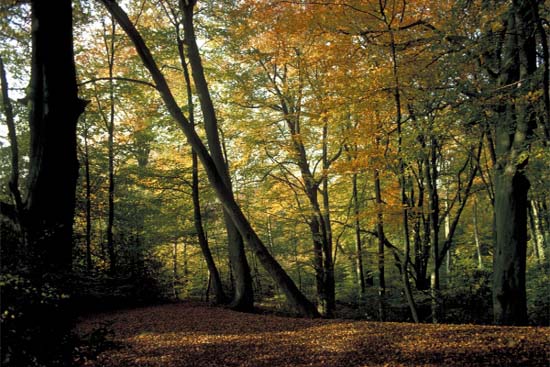Burnham Beeches: England's Ancient Wood
by Lisa Agnew
Nestled almost on the southern Buckinghamshire/northern Berkshire border, the village of Burnham is neighbour to historic Burnham Beeches, described as one of the finest woodland tracts anywhere in Britain. The remnants of a vast forest that once covered almost the entire county of Buckinghamshire, it is owned and managed by the Corporation of London who, in 1880, bought the woodland to save it from prospective developers. Bounded by Windsor, Maidenhead and Slough, Burnham and Burnham Beeches are within the area around London now protected from further encroachment by Green Belt legislation. The village itself is mentioned in the Domesday Book, although there has more than likely been a settlement on the site since well before the Romans came.

In the Domesday Book, the manor of Burnham is recorded as belonging to 'Walter, son of Other'. Upon Walter's demise, his son William took possession of the manor, as well as a new soon-to-be auspicious surname -- Windsor. The manor remained in the family's possession until 1204, when it was split between two new owners. An abbey was founded there in 1266, and in 1271 the abbess was granted a formal market, to take place on Thursdays. Strategically situated between London, Oxford and Bath, Burnham was ideally situated to take advantage of through traffic between the major towns, with the abbey often taking on the role of overnight resting station. The commerce brought with these travellers turned Burnham from a village into a bustling town, which it remained until the building of a bridge in neighboring Maidenhead, when that town began to prosper at Burnham's expense.
The historic parish church of St Peter can be found off the Burnham's High St, an ancient building with a fine 13th century tower that also boasts several wonderful stained glass pieces. Burnham Abbey also still stands, possibly thanks to being briefly owned by William Tyndale (1495-1536), the man who translated the Bible into English.
The Beeches are north of the village, reached via Hogfair Lane to the left of the High Street, then left into Britwell Rd and left once more onto Grove Road, which will eventually lead right into the ancient woodland. From there, one can either delve left onto Pumpkin Hill, or right, passed the office building and into the Lord Mayor's Drive (with the enigmatically named Druid's Oak on the right-hand side) or continue on the peripheral road -- Hawthorn Lane. The average age of the pollarded trees is estimated to be well in excess of 400 years. The largest tree, probably also the oldest, is the "Druid's Oak" -- almost certainly greater than 800 years old.
At 540 acres, the interior of the Beeches offers many easy walks as well as chances for some sly comparisons to the locations of many comparatively recent movies. Burnham Beeches is in fact a favorite location shoot, having stood in for Sherwood Forest in Robin Hood, Prince of Thieves, an Irish woodland in The Crying Game, ancient generic England in First Knight and Ivanhoe, and even a more tropical setting in A Town Like Alice. Off to the left of Park Lane lies Dorney Wood, a favorite haunt of footpads during the reign of Henry VIII. The entire area around Burnham was inundated with highwaymen during the Middle Ages, so much so that it was said that the Vicar of nearby Hurley got danger money for riding through the region. Further along on the right is a convenient parking area for those interested in viewing Hardicanute's Moat, a diamond-shaped earthwork of unknown origin.
In the far north-west corner of Burnham Beeches is the hamlet of Egypt. Why it was christened after the country in Northern Africa is also lost in history, but this pleasant little hamlet is another attractive reason to tarry awhile around the Buckinghamshire/Berkshire border.
How to Get There:
Take the M4 motorway west out of London. Leave the motorway at either Junction 6 or Junction 7A. Both will take you to Burnham, however Junction 6 is the most direct route to Burnham Beeches.
More Information:
We regret that we no longer have the resources to maintain up-to-date links and/or hours and pricing details for the various sites and attractions listed on this website. For more information about the location(s) listed above, please use your favorite search engine or visit Wikipedia.
Lisa Agnew is a freelance writer of articles and speculative fiction. She is based in Auckland, New Zealand. English by birth, she harbours a life-long fascination with the history and folklore of her native land.
Article © 2005 Lisa Agnew
Photo © Britainonview.com
|
